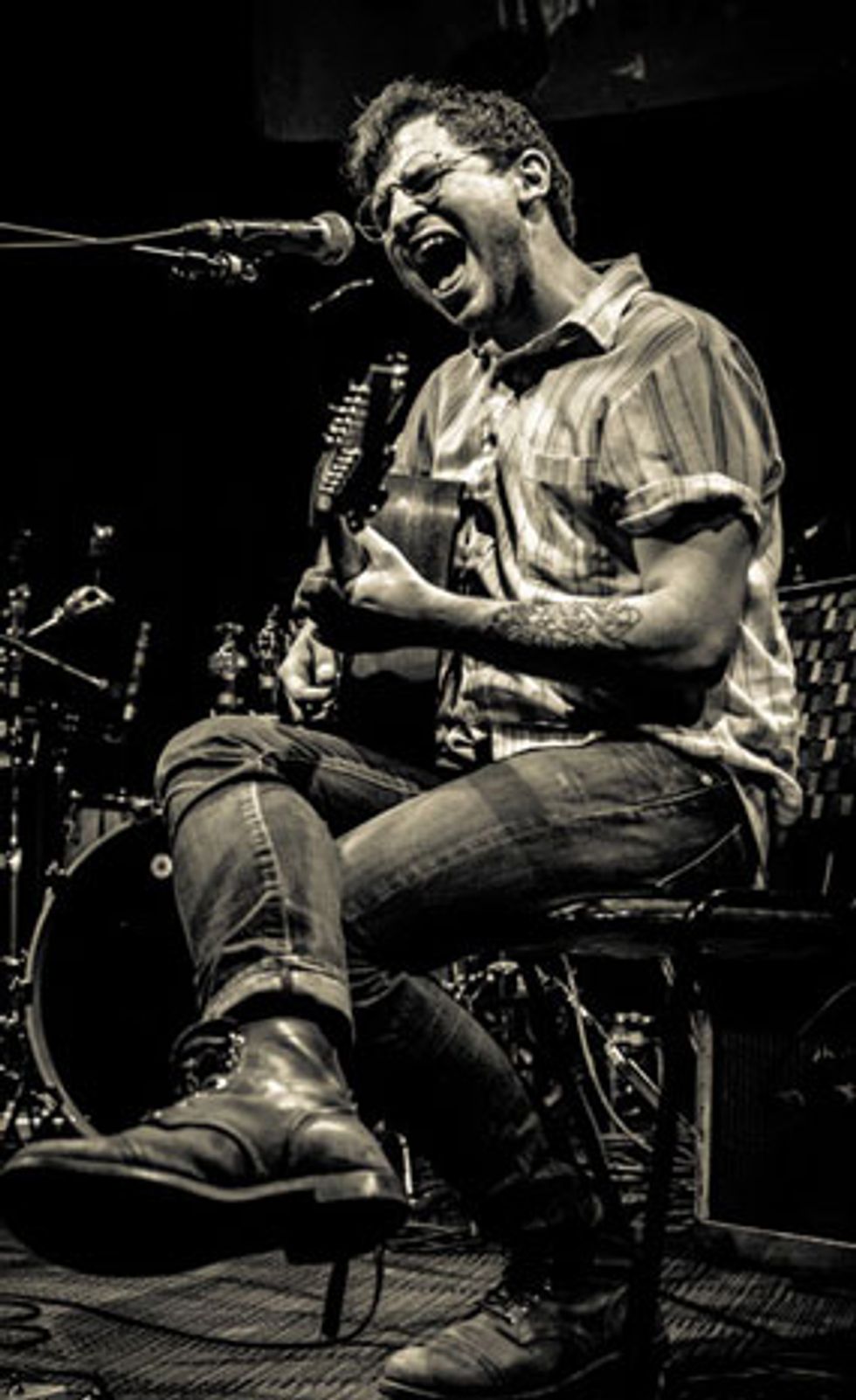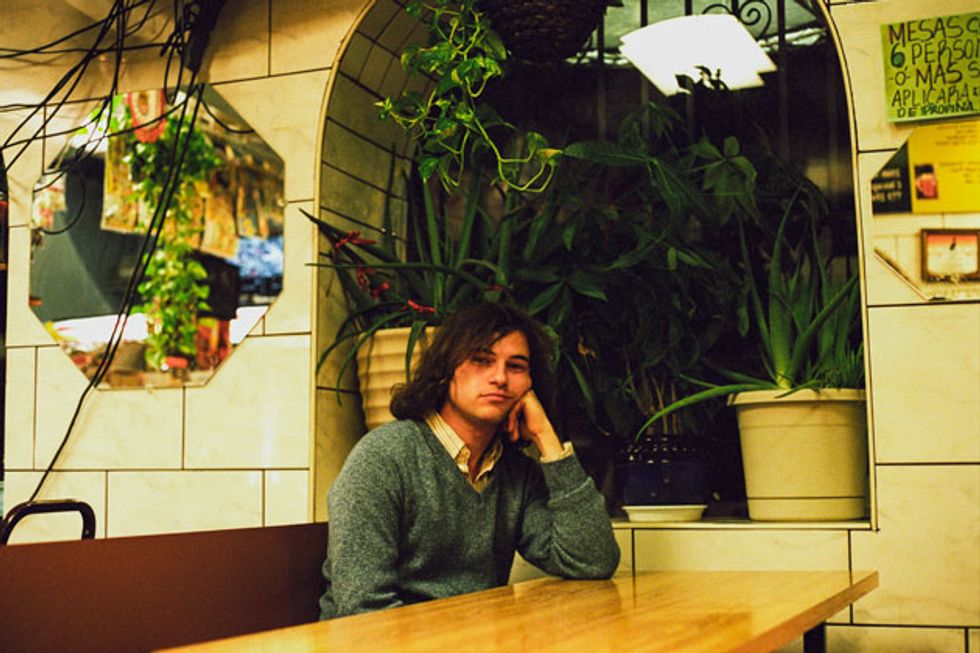At first glance, Primrose Green, the new release from Chicago-area fingerstylist Ryley Walker, conjures up some serious ’70s mojo. Just dig the cover art—an overdose of green; long, flowing hair; a fistful of wild flowers; and a photograph that oozes Van Morrison. But don’t miss the point: Walker is anything but a throwback. He boasts prodigious skill, an ear for diverse styles, and a knack for attracting Chicago’s top talent as sidemen. He is a creative, cutting-edge player with deep roots and a willingness to give a nod to the past.
Walker grew up in Rockford, Illinois, about an hour northwest of Chicago. His interest in music started with Led Zeppelin. “That’s the genesis of some kid from Rockford, Illinois,” he says. “Getting into music is to get into Led Zeppelin.”
Eager to expand his sonic horizons, Walker used Zeppelin as a gateway to older music. “‘Black Mountain Side’ is a rip-off of a Bert Jansch song,” he says, “so that’s how I heard about Bert Jansch. They had a song called ‘Hats Off to Roy Harper.’ I thought, ‘Who the hell is Roy Harper?’”
But as a millennial, Walker was also interested in contemporary music. He listened to Dinosaur Jr. and Sonic Youth, played in punk bands, and threw his guitars around. “I played in a lot of noise bands. It was like every part of your body was your guitar pick. Slam it on the ground or just destroy it—it was like anti-guitar music with a guitar.”
After high school, Walker moved to Chicago. He flirted with college, but it wasn’t to be. “I figured going to shows at night instead of going to school was better for me.” He was a student of Chicago’s eclectic music scene and made it his business to attend performances of local legends like Jeff Parker (Tortoise, Chicago Underground). But the acoustic guitar was calling. “Along with a lot of roots music, I got huge into John Fahey, Sandy Bull, and stuff like that—super far-out acoustic guitarists.”
Walker soaked in the sounds and practiced, and his discipline paid off: At age 26, he has superior chops, mature tone, impressive musicality, and advanced mastery of the instrument. He recorded Primrose Green—his second full-length album—in Chicago. It features a cast of local jazz heavies, including Ben Boye on keys, bassist Anton Hatwich, drummer Frank Rosaly, Whitney Johnson on viola, and cellist Fred Lonberg-Holm. Open, loose, and improvisatory, the album serves as a showcase for Walker’s songwriting and playing.
It’s also evidence of the current state of acoustic guitar, which, according to Walker, is in great shape. “It’s pretty easy to meet a good guitarist these days,” he says. “There is so much good guitar happening right now.”

Walker digs into his Martin D12-28 at this year’s NON-COMMvention at World Café Live in Philadelphia.
Photo by Jesse Barnett.
Although it isn’t a jazz album, Primrose Green has a lot of jazz overtones. It reminds me of those Joni Mitchell albums with Jaco Pastorius.
Those albums are great. Mine has jazz dudes on it—no doubt that influence is in there—but I don’t think of it as a jazz record. It’s a folk record.
Yet it’s very open. How much leeway do you give your sidemen to jam or create parts?
Man, there’s total freedom. They are some of the best musicians in the world, really great improvisers. They travel all over the planet doing what they do, and I’m not about to stop them from doing that. It’s huge for me to have those guys playing with me.
Describe your composing process.
A lot of new songs come from messing around with tunings. I just sit around at home and try to find a new weird tuning, and then I improvise off that until it eventually becomes a song.
Do you have certain go-to tunings?
Not go-to tunings, but there are ones that are a little more prominent on the record. Tunings are like buried treasure, man. You look and look, and then you find one and you’re just, “Whoa. Sick.” I call tunings the “baseball cards of fingerstyle guitar” because you trade your tunings. You’re like, “Oh man, you gotta check out this tuning.” And you meet a guy who says, “Check out this tuning I have.” And you think, “What the fuck? Where did you get that tuning?” There are a few I use more frequently than others, I suppose.
Like what?
From the low end, “Primrose Green” is C–G–D–G–C–D. I love that tuning and use it on quite a few tunes. Its range is so sick and you can find a nice melody all over it. It’s a really forgiving tuning.
What are some others?
I have a few tunes in D–A–D–D–A–D. John Martyn used that one a lot. I really like that—you just tune the G string all the way down to D. And there is this new tuning that Steve Gunn told me about where you tune the low E up to a G and everything else is like standard: G–A–D–G–B–E. That is really cool.
Walker’s main flattop is a ’70s Guild D-35. “That guitar rules—I’ll keep it forever,” he says. Photo by William van der Voort.
Are you as comfortable moving around in various tunings as you are in standard? Are you better at certain tunings?
Oh yeah, absolutely, like the ones I mentioned. You should put an infinity symbol above all the tunings. It’s endless. You can find so many new things within them when you improvise live and try weird new sounds. And it’s really rewarding when that happens.
Have you tried any of Nick Drake’s tunings?
I’ve never copped a Nick Drake tuning specifically. I think he used E–A–D–F#–B–E a lot, where you just tune the G down to an F#, which I like a lot. He had crazy tunings. I love crazy tunings, but live they can be a pain in the ass. The audience is just sitting there while you’re going, “hold on.”
You use a capo with your altered tunings.
I play a lot in open tunings and sometimes the capo really helps me find a place with my voice. I’m a big fan of capoing between the 1st and 4th frets. There’s just so much joy once you can raise an open tuning up a bit. A capo is the ultimate tool. I love it.
Primrose Green has a different feel from your previous album, All Kinds of You. Did you set out to do something different?
A lot of it just comes from the band. They are jazz guys, so we had a lot of different energy in there. It was a new band and it was really refreshing. We recorded the album really quickly—we did it in a day and a lot of it was created right there on the spot. That whole vibe affects the record.
How do you approach playing music that’s rooted in the sounds of an earlier era without being a revivalist or folklorist?
I’m always looking to do something of my own. I take a lot of inspiration from earlier music, but I don’t want to be some sort of revivalist—that’s a whole other racket. I like older records a lot, but I need to do my stuff.
Do you listen to world music?
Oh yeah. As far as guitarists go, Ali Farka Touré. All the West African guitarists are like mind, mind, mind-blowing, and you can get these compilations of street music from Asia and find all these weird melodies. Taking in music from all around the world is important to me.
Gear
Guitars
1975 Guild D-35
’70s-era Martin D12-28 12-string
Pickup and Preamp
L.R. Baggs M1 magnetic soundhole pickup
Radial Tonebone PZ-Deluxe preamp
Amps
’70s-era Gibson Explorer 1x12 combo
Strings and Picks
John Pearse 700M Phosphor Bronze Wound (.013–.056)
Tell us about your guitars.
I have a 1975 Guild D-35 and a Martin D12-28 12-string from the ’70s. I don’t know what year it was made.
Have you had them for a while?
The 12-string is pretty new, but I got the Guild about five years ago. That guitar rules—I’ll keep it forever. I don’t think there’s a finer guitar. It’s so durable, and it plays perfectly. You can drop it on the ground and nothing will happen to it. They built them so good.
How do you amplify your guitar onstage?
I used to just put a mic on it, but now that I’m with the band, it’s starting to get more complicated.
Now I have an L.R. Baggs [M1] passive soundhole pickup, and I plug that into an acoustic preamp,
the Radial Tonebone PZ-Deluxe.
The L.R. Baggs pickup is pretty inexpensive, and because it’s passive you can just keep it in there—you don’t have to change batteries. It works perfectly and sounds just fine. I’ve never had a problem with it.
Onstage I play through an old Gibson Explorer amp. I used to hate amps on acoustic guitar, but since I’ve been playing with the band, I’ve discovered it’s really cool—it gives me this beautiful bottom end.
The Radial preamp goes into the Explorer, which we mike. Then I also use the preamp’s XLR out to feed the PA. We mix those two signals in the PA, and it’s just an all-around balanced sound. It still sounds like an acoustic guitar, not like a shitty electric guitar. It took a lot of trial and error to find a good acoustic guitar sound, but I’m way into this one. Sending a DI acoustic guitar signal straight into the PA is just a godforsaken abomination of sound.
Have you tried an under-saddle piezo pickup?
No, I don’t like disappearing acts for the pickups. I like seeing them because they look cool—kind of. I’m not a super-huge gear dude, so I’m not interested in having some weird, mad scientist guitar. You just screw this pickup in and out, no bullshit. And you don’t have to install anything. It’s just so easy.
“I take a lot of inspiration from earlier music,” says Walker, “but I don’t want to be some sort of revivalist—
that’s a whole other racket.”
Describe your Gibson Explorer.
It’s a combo from the mid ’70s. It has one 12" speaker, power on and off, tone, and volume—that’s it. That’s all I need. I have an EQ on the preamp if I need to tweak the sound more specifically.
Did you use the Explorer in the studio, too?
In the studio I had that rig I use live, but we also set up two microphones for the guitar as well. That allowed me to get every aching bit of guitar I could possibly want on the album.
Did you set up in a separate room?
No, we were all in the same room. It was all live.
You weren’t worried about leakage?
Man, there were no problems at all from my man Cooper [engineer Cooper Crain] who recorded this album. And I like leakage. We weren’t trying to make something that sounds perfect. I wanted it to feel like a live record, so that’s how we approached it.
Did you do any overdubbing?
Not really, just vocals.
What do you use for strings?
Medium-gauge John Pearse phosphor bronze. The conversation is over on acoustic guitar strings. John Pearse. Boom. Done. Now if someone wants to give me free strings ... [laughs]. But I use John Pearse.
YouTube It
In this 29-minute set, Ryley Walker caresses, strums, plucks, and thrashes his Guild D-35, sings of love and loss, and converses candidly with the show’s host about his musical heroes.
Those mediums are gauged .013 to .056—that’s pretty heavy.
Yeah man, but I love it. To me, light strings are like a little garden hose. But a medium set of John Pearse strings is like a waterfall. I swear by them.
What about picks?
I use a thumbpick, as well as acrylic nails on my pointer, middle, and ring fingers.
Why not just use fingerpicks?
I think fingerpicks sound like shit. I know a lot of people like them, but to my ears they make this weird scraping sound. The way I play, I like to get under the strings and pull on them to make them pop. You can’t get that sound with fingerpicks—you cannot pull from under the string at all. I prefer acrylics because I like having the pick on top of my finger instead of the pick being under my finger pad.
Have you tried simply growing your nails?
I used to all the time, but when you’re on tour and your nail chips, it’s what-the-fuck? The acrylics are more permanent. They don’t sound as good as nails, obviously, but they’re a more permanent solution to chipping a nail. It’s just better insurance when touring.
I go to a nail salon. You could do it yourself, but for me, getting my nails done is like going to church on Sunday. It’s just a good activity.













![Rig Rundown: Russian Circles’ Mike Sullivan [2025]](https://www.premierguitar.com/media-library/youtube.jpg?id=62303631&width=1245&height=700&quality=70&coordinates=0%2C0%2C0%2C0)
























